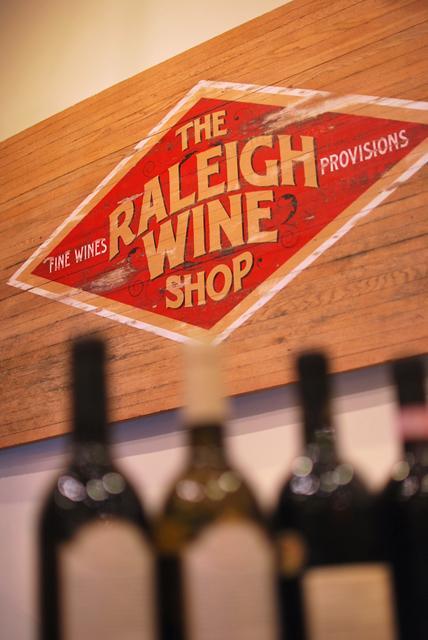
© NCSU Student Media 2012
The Raleigh Wine Shop on Glenwood Avenue gives guests a honest way of choosing wines with owners, Seth Hoffman, Jeff Bramwell, and Ryan Fulkerson who handle everything in store. Photo by Ben Tran
Natural Light and Burnett’s are staples at college parties, but they may have to share the limelight with a more sophisticated beverage. With vineyards all across the state, it was only a matter of time until wine made its way onto N.C . State’s campus and the guest list of nearly every party.
Arielle Vari , a junior in nutrition science, grew up around wine, so it was natural for her to begin enjoying it as she became older.
“My family is Italian, and they always drank wine,” Vari said. “I grew up being exposed to it.”
But for others, wine is uncharted territory. Ryan Fulkerson , an NCSU alumnus, along with his partners Jeff Bramwell and Seth Hoffman, are co-owners of The Raleigh Wine Shop. They offered a brief summary on different types of red and white wines.
Popular red wines, in order from fuller-bodied to lighter, are Cabernet Sauvignon, Syrah/Shiraz, Malbec and Pinot Noir. Cabernet is from France, California and Washington, while Syrah is from Australia. For many of the past few years, Malbec has been a consistent go-to cheap red wine.
Popular white wines, also in order from fuller-bodied to lighter, are Riesling, which is often sweet, Chardonnay, Sauvignon Blanc and Pinot Grigio /Gris. All these wines originated in France.
The temperature of the wine is a topic that is frequently raised. “Red wines are okay at room temperature, but if you can pop it in the refrigerator for five to ten minutes, you can get it at the perfect temperature,” Bramwell said. “White wines are best when you let them chill in the fridge for about 45 minutes first. A general tip is the lighter the white wine, the cooler you can drink it.”
The old adage of pairing white meats with white wine and red meats with red wine still holds true, although Fulkerson suggests choosing a favorite. “Wine shouldn’t be any more intimidating than it has to be,” Fulkerson said. “Try and see what you like; be up for trying new things.”
Bramwell and Hoffman agree; the way a wine is chosen should be more about personal preferences and less about preconceived wine standards. “There’s an occasion for every wine, and people should explore both the red and white spectrum with disregard to stereotypes and misconceptions,” Bramwell said.
“The great thing about wine is that much of it is opinion,” Hoffman said. “It allows you to explore and experiment and find out what fits your palate.”
Kurt Saylor of The Wine Merchant of Cary also said choosing a wine should be about personal exploration.”There are two ways to develop the palate,” Saylor said. “The first is through reading; books, magazines, internet articles and anything else offering advice in sampling and the second is, of course, by tasting.”
Experimenting and learning about wine is the easiest way to become a wine connoisseur. “Once you learn to associate names with certain flavors, your palate will develop,” Saylor said.
While getting into wine seems like a lot of unnecessary work, Bramwell gives some advice on getting started. “Don’t fear your local wine shop,” Bramwell said. “Take the time to search out wines with character.”
Many wine retailers offer weekend wine tastings, including The Raleigh Wine Shop and The Wine Merchant of Cary.
Cost is a determining factor for most college students. While wine can be expensive, many retailers, like Saylor , showcase local vineyards to make the beverage accessible to all who are of age, free of charge.
Attending these vineyard showcases is not only cheaper, but also helps to support local growing vineyards in NC. “By buying locally made wines, you are getting an equally great wine for a lower price and supporting growers in the area,” Saylor said.
With options like these and a little time and curiosity, it’s simple for college students to learn more about wine and perhaps even discover a few favorites.
Vari , with help from her Italian family and personal exploration at college, has begun to develop her own preferences. “I prefer red wine, specifically Cabernet Sauvignon, but lately I’ve been drinking Yellowtail, since it’s a good quality wine at an attractive price,” Vari said. “I like enjoying a glass of wine at dinner or when I’m out with my friends or boyfriend; it’s become an enjoyable aspect of life.”
Alt:
Fun facts about wine:
1. Studies show that red wine has polyphenols , which are proven to guard the lining of the heart’s blood vessels and protect against cardiovascular disease.
2. A chemical in red wine called resveratrol has been shown to have cardio protective and chemo protective effects in animal studies.
3. A 2007 study found that wine is an effective anti-bacterial agent against strains of Streptococcus (strep throat).
4. A 2008 report stated moderate red wine consumption may decrease the risk of lung cancer in men.